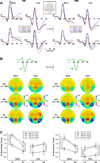A neurophysiological deficit in early visual processing in schizophrenia patients with auditory hallucinations
- PMID: 22803512
- PMCID: PMC3419781
- DOI: 10.1111/j.1469-8986.2012.01404.x
A neurophysiological deficit in early visual processing in schizophrenia patients with auditory hallucinations
Abstract
Existing 67-channel event-related potentials, obtained during recognition and working memory paradigms with words or faces, were used to examine early visual processing in schizophrenia patients prone to auditory hallucinations (AH, n = 26) or not (NH, n = 49) and healthy controls (HC, n = 46). Current source density (CSD) transforms revealed distinct, strongly left- (words) or right-lateralized (faces; N170) inferior-temporal N1 sinks (150 ms) in each group. N1 was quantified by temporal PCA of peak-adjusted CSDs. For words and faces in both paradigms, N1 was substantially reduced in AH compared with NH and HC, who did not differ from each other. The difference in N1 between AH and NH was not due to overall symptom severity or performance accuracy, with both groups showing comparable memory deficits. Our findings extend prior reports of reduced auditory N1 in AH, suggesting a broader early perceptual integration deficit that is not limited to the auditory modality.
Copyright © 2012 Society for Psychophysiological Research.
Figures


Similar articles
-
The multimodal connectivity of the hippocampal complex in auditory and visual hallucinations.Mol Psychiatry. 2014 Feb;19(2):184-91. doi: 10.1038/mp.2012.181. Epub 2013 Jan 15. Mol Psychiatry. 2014. PMID: 23318999
-
Stimulus- and response-locked neuronal generator patterns of auditory and visual word recognition memory in schizophrenia.Int J Psychophysiol. 2009 Sep;73(3):186-206. doi: 10.1016/j.ijpsycho.2009.02.003. Epub 2009 Mar 9. Int J Psychophysiol. 2009. PMID: 19275917 Free PMC article.
-
Current source density (CSD) old/new effects during recognition memory for words and faces in schizophrenia and in healthy adults.Int J Psychophysiol. 2010 Feb;75(2):194-210. doi: 10.1016/j.ijpsycho.2009.12.001. Epub 2009 Dec 6. Int J Psychophysiol. 2010. PMID: 19995583 Free PMC article.
-
Review of neurophysiological findings in patients with schizophrenia.Psychiatry Clin Neurosci. 2013 Nov;67(7):461-70. doi: 10.1111/pcn.12090. Epub 2013 Sep 19. Psychiatry Clin Neurosci. 2013. PMID: 24102977 Review.
-
A possible key role of vision in the development of schizophrenia.Rev Neurosci. 2019 May 27;30(4):359-379. doi: 10.1515/revneuro-2018-0022. Rev Neurosci. 2019. PMID: 30244235 Review.
Cited by
-
Nicotine, Auditory Sensory Memory, and sustained Attention in a Human Ketamine Model of Schizophrenia: Moderating Influence of a Hallucinatory Trait.Front Pharmacol. 2012 Sep 28;3:172. doi: 10.3389/fphar.2012.00172. eCollection 2012. Front Pharmacol. 2012. PMID: 23060793 Free PMC article.
-
The use of current source density as electrophysiological correlates in neuropsychiatric disorders: A review of human studies.Int J Psychophysiol. 2015 Sep;97(3):310-22. doi: 10.1016/j.ijpsycho.2014.10.013. Epub 2014 Nov 6. Int J Psychophysiol. 2015. PMID: 25448264 Free PMC article. Review.
-
Auditory Target and Novelty Processing in Patients with Unilateral Hippocampal Sclerosis: A Current-Source Density Study.Sci Rep. 2017 May 9;7(1):1612. doi: 10.1038/s41598-017-01531-8. Sci Rep. 2017. PMID: 28487515 Free PMC article.
-
Postural Sway and Clinical Characteristics in Patients with Psychotic Disorders: A Review.Psychiatr Q. 2015 Dec;86(4):603-14. doi: 10.1007/s11126-015-9355-5. Psychiatr Q. 2015. PMID: 25791471
-
Demonstrating test-retest reliability of electrophysiological measures for healthy adults in a multisite study of biomarkers of antidepressant treatment response.Psychophysiology. 2017 Jan;54(1):34-50. doi: 10.1111/psyp.12758. Psychophysiology. 2017. PMID: 28000259 Free PMC article.
References
-
- Allen P, Laroi F, McGuire PK, Aleman A. The hallucinating brain: a review of structural and functional neuroimaging studies of hallucinations. Neuroscience and Biobehavioral Reviews. 2008;32:175–191. - PubMed
-
- American Psychiatric Association, editor. Diagnostic and Statistical Manual of the Mental Disorders. Fourth Edition (DSM-IV) Washington, DC: American Psychiatric Association; 1994.
-
- Andreasen NC. The Scale for the Assessment of Negative Symptoms (SANS) Iowa City, IA: The University of Iowa; 1983.
-
- Andreasen NC. The Scale for the Assessment of Positive Symptoms (SAPS) Iowa City, IA: The University of Iowa; 1984.
-
- Badcock JC, Hugdahl K. Cognitive mechanisms of auditory verbal hallucinations in psychotic and non-psychotic groups. Neuroscience and Biobehavioral Reviews. 2012;36:431–438. - PubMed
Publication types
MeSH terms
Grants and funding
LinkOut - more resources
Full Text Sources
Medical

